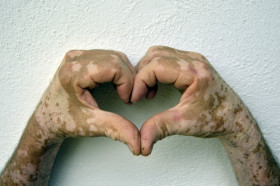
If your baby is jaundiced, alert your baby's healthcare provider or a nurse.As you age, the skin tends to become flaccid and loose and it is called crepey skin. Treatment may be needed to help the bilirubin break down and get rid of the yellow color. This is especially true of babies born early, or prematurely. But sometimes a baby’s liver can’t process bilirubin as quickly as needed. Jaundice occurs in about half of all babies after birth, and usually goes away by itself. It leaves the body through the urine or stool. This substance is processed by the baby’s liver. The breakdown releases a yellow substance called bilirubin, which causes the yellow color. It happens because the body is breaking down red blood cells (a normal process after birth). It usually starts in the face, then moves down to the chest, lower belly, and legs. Jaundice is a yellowing of the skin and the whites of the eyes. Tell your baby's healthcare provider or a nurse right away if you notice mottling. In other babies, it could be due to a congenital heart problem, poor blood circulation, or an infection. Mottling is not uncommon in premature or ill babies in the neonatal intensive care unit. The parts of the skin that are not blotchy may be very pale (this is called pallor). There may also be a bluish marbled or weblike pattern on the baby’s skin. Mottling occurs when the baby’s skin looks blue or pale and blotchy. If you notice cyanosis, tell your baby's healthcare provider or a nurse right away. It may mean the baby is not getting enough oxygen. It happens when the baby’s red blood cells aren't carrying as much oxygen as expected. CyanosisĬyanosis can be a blue color around the mouth or face, or over the whole body. This is normal, and will go away by itself. Later, acrocyanosis can come back if the baby is cold (such as after a bath). The problem goes away as the baby's body gets used to new blood circulation patterns. It happens because blood and oxygen are circulating to the most important parts of the body such as the brain, lungs, and kidneys rather than to the hands and feet. In fact, most newborns have some acrocyanosis for their first few hours of life. With acrocyanosis, the baby’s hands and feet are blue.


But skin color changes may be more obvious in babies born early, or prematurely, who have thinner skin than full-term babies. The changes described below can happen to any newborn.

In newborns, skin color changes are often due to something happening inside the body.


 0 kommentar(er)
0 kommentar(er)
